One sunny day, in Leo Lapa, Lin mentioned that she hoped this story would have a plot.
Since it’s always wise to listen to your principal characters, I suppose I’ll have to do my best to find one. I’m not having much luck so far, though we do have quite a satisfying back story. Long ago, in the mists of 2011, a certain grandmaster won the Commonwealth Chess Championship, held that year in South Africa, and therefore also encompassing the South African Chess Championship. By an uncharacteristically acute piece of forward thinking twenty-three years earlier, I’d arranged to be the mother of the said grandmaster, our eldest son Gawain (pictured left)
So when one of the prizes for the SACC turned out to be a week’s holiday for ten people at the Leo Lapa lodge on the fringes of the Kruger National Park, and when Gawain and his lovely and accomplished fiancée Sue (pictured right) decided to have their wedding there, I was ideally placed to angle for an invitation. (Actually I didn’t; I thought they were inviting friends only, and when they asked me I was overwhelmed, enchanted, tearful, dithery and generally behaved like a dishcloth that’s suddenly found itself invited to become a napkin for the royal garden party.)
So, this is the story of my journey to South Africa, of the week we spent there (not including the wedding itself, which was magical, but far too precious for the hurly-burly of the blogosphere) and the journey back again, which turned out to be slightly less straightforward than first envisaged. So, it has a narrative structure; we shall have to see whether or not Lin’s plot emerges.
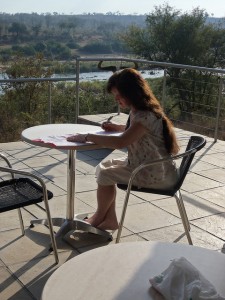 The first part of the journal contains the contemporaneous bits, written in odd moments on buses, planes, upon waking in Leo Lapa, on the sunny terrace and before going to bed. As I might have anticipated, however, there was far too much to do and see to find even a fraction of the time needed to write it all down, and the rest had to be added from the comparative calm of an Irish July, sitting in the study looking out at the rain. I hope it makes sense; life is, I’m afraid, far too short for the cut-and-pasting that would be necessary to put it into one chronological sequence, but I daresay you’ll get the general idea. (In case you hadn’t guessed, the picture left, taken by Ross or Lin, shows me on the terrace, not having time to write everything down.)
The first part of the journal contains the contemporaneous bits, written in odd moments on buses, planes, upon waking in Leo Lapa, on the sunny terrace and before going to bed. As I might have anticipated, however, there was far too much to do and see to find even a fraction of the time needed to write it all down, and the rest had to be added from the comparative calm of an Irish July, sitting in the study looking out at the rain. I hope it makes sense; life is, I’m afraid, far too short for the cut-and-pasting that would be necessary to put it into one chronological sequence, but I daresay you’ll get the general idea. (In case you hadn’t guessed, the picture left, taken by Ross or Lin, shows me on the terrace, not having time to write everything down.)
My outward journey, to avoid unnecessary mystification, was as follows:
bus Enniskillen – Dublin airport
plane Dublin – Paris
plane Paris – Johannesburg
minibus Johannesburg – Leo Lapa
and the return trip the same, except with Amsterdam in place of Paris.
Part One
Thursday 7th June, 12.15pm, Enniskillen
Torrential rain from a white-grey sky as the Dublin bus wheezes out of the town. Everything is wet, from the brash new Jubilee flags along the loyalist estate to the blocks of empty flats, built – in several cases half-built – during the encroachment north of the great Irish property bubble of a few years past. The man behind me is talking on his phone, asking, without any particular animosity, whether the bus from fucking Derry to fucking Dublin stops in fucking Omagh.
12.45pm, Belturbet
The man in the seat opposite has been praying aloud, which he now follows with a soft and tuneful hymn. Meanwhile an uncertain looking elderly priest is waiting at the the bus stop, carrying a small backpack from which dangles an old-fashioned brown card label. It is still raining.
1pm, Cavan
In Ireland, buses and bus stations, along with post offices, are the best places to encounter blow-ins like myself. Behind me, two young women are talking animatedly in, I think, Polish, while a glamorous Middle Eastern man and his (son, nephew?) enjoy a last insouciant cigarette before the bus goes on. Reading about the history of the Kruger National Park and the immense opposition faced by both Paul Kruger himself and the first warden, Colonel Stevenson-Hamilton, I notice the parallels with climate change campaigning now. Even closer to home, some of their greatest battles seem to have been against the mining companies.
3.30pm, Dublin Airport
I arrived too early to check in, but the Air France staff confirmed that I and my bag will be able to be checked right through to Johannesburg. As I had time to spare on this side of security, I asked a nice woman at one of the Currency Exchange outlets whether I could pick up the rand I’d ordered there. They didn’t have enough, but she directed me to Kathryn, her equally nice colleague at the other end of the hall, who did. So I managed to change one of the 500 euro notes which have been hanging around since I got them from Gawain in March, for nearly fifty buffalo-adorned 100 rand notes. That feels a lot more substantial. I don’t know whether the Currency Exchange people are always so full of bonhomie or whether it’s the Fr. Dougal style Irish football shirts they’re all wearing, and the green and orange balloons with which their booths are festooned.
5.45pm, Dublin Airport My bag and I are checked through to Johannesburg – hope we arrive there at roughly the same time. It was the same woman – lovely red hair – at the check-in desk, and she remembered me, though had to call a supervisor to coax the computer into printing my second boarding card. I’m now in the showing area for the Jameson Done in 60 Seconds films, which is rather pleasant, so will ruminate here for a while. Oh, I got searched at security after setting the bleeper off as I went through the archway-thingy. At first I thought that it was my watch, then the beads on my top, but realised afterwards that I’m wearing an underwired bra. Hope it doesn’t hold me up (no pun intended) too much in Paris.
6.30pm, Dublin Airport
At the gate. There are French people, speaking French with great enthusiasm and much gesticulation, as though specially planted here to reassure us that, yes, this is indeed the flight to Paris, and the Air France one to boot, unlike the Ryanair flight that goes at the same time, probably to some other airport optimistically described as ‘Paris’ but located in an outer suburb of Calais. And no doubt the passengers at that gate are accordingly subdued and unParisian. One of ours just said something suspiciously like ‘Ooh la la!‘ while the bearded chap opposite me, though obviously not with the excitable women, had no qualms about joining in their conversation to make a mot juste. It’s all, needless to say, far too fast and colloquial for me to understand more than an isolated word, mais or mere, neither of which are much help out of context. I had a cheese sandwich while sitting in the film place, not knowing otherwise when I’ll have the chance to eat something and the Wetherspoons’ breakfast starting to wear off. I’ll avoid alcohol, though (unless it’s free, in which case it clearly has no intoxicating powers, just as free food has no calories) until I’m safely installed with Helen at the Paris gate. L28, the boarding card tells me, which sounds reassuring, with the destination of ‘Johannesbourg’ pleasingly Continental. Not sure about the ‘N B Weight’ under the gate number, though – it was only a cheese sandwich. Anyway, the red-haired woman was also encouraging about the ease of the transfer process.
A text has just arrived from Paul (Helen’s husband) – her flight was forty minutes late leaving Heathrow, but she had oodles of time so this should be fine. Hope ours isn’t delayed by so much, though.
9.50pm, somewhere over Northern France
Looking optimistic at the moment – fifteen minutes ago the pilot announced that we were flying over Brighton and due to land in Paris five minutes early. I am sitting between two Frenchmen (so have no hope of either armrest); one distinctly irascible – tapping his fingers on anything firm enough (so not me, obviously) and sighing loudly. I’ve been given a complimentary glass of wine and another cheese sandwich while I read Richard Estes’ Safari Companion detailing the behaviour of all the species I’m likely to see (apart from wedding guests, who are sui generis). Have concluded that I’m a giraffe, despite appearances to the contrary – females spend half the day browsing and at night lie down and ruminate.
Friday 8th June, 12.15pm, somewhere between Johannesburg and Nelspruit, South Africa
Am now in the minibus with Mornay and the other nine members of the wedding party, heading across the golden veldt. But it all could have been so different. My last entry, as it admitted, was optimistic. Blasé might be a more accurate word, or, without being unduly harsh, complacent. Yes,the flight from Dublin did land five minutes early. The problem was that it landed several miles away from its designated gate. More when writing is easier …
Around 7pm (accidentally pulled the winder out on my watch, so I’m guessing), Leo Lapa
and when I’ve had some sleep. More in the short term later, anyway.
7.30pm, Leo Lapa
Yes, we’re here (most of us; just waiting for Ga, Sue, Ross and Lin to get back from their wedding arrangements/shopping in Nelspruit) and it’s utterly wonderful, quite beyond my present powers of description.
So, back to the flight from Dublin. I made sure to get off the plane promptly, only to find myself wedged at the back of the bus behind all the amblers. I’m used to shuttle buses; even ferries have them, so no particular alarm bells were yet ringing. In a minute, a couple of minutes, a few minutes, er, sometime, we would stop. And we did. That was when I started to feel a little concerned, when I saw the large signs directing us to Terminal 2E. Er, wasn’t Terminal 2E where we were supposed to have landed, and, more importantly for present purposes, also where the plane for Johannesburg was supposed to set off from?
Saturday 9th June, 5.30am, Leo Lapa
Helen has just brought me a cup of tea as we gently ease ourselves into the day. Formal activities begin at 6.30 with an early safari. I think that will be just about sunrise. It’s one thing that’s confusing for those of us from the northern hemisphere; the fact that, although the weather is as warm and sunny as the best of our summers, it is in fact winter, with a correspondingly late dawn and early sunset. Outside, the horizon is black tree silhouettes against a strip of red sky, fading to orange. Above it the sky is blue with a few low stars. It feels so strange to be surrounded by these quintessential African images – like accidentally straying into a fairy tale.
Back to Thursday night, and to cut what felt like a very long story short, I followed a man with a cardboard ‘Pekin’ sign, urged on by the airport staff who, in response to my repeated and plaintive enquiries of ‘Johannesburg?’ replied only, ‘Follow that group.’ Our Pied Piper led us to the platform for a transit train, was told by a man (one of those random individuals who appear from nowhere in dreams such as these) that the transit wasn’t going, or wasn’t going to Terminal 4E, or wasn’t going to help us, something decidedly unpromising anyway, so that our guide wheeled around and led us instead outside and onto another bus.
At the end of this, thankfully shorter, trip, we were at some species of security, where my underwired bra once again let me down (metaphorically speaking – physically M&S continued to live up to their reputation) and through to, joy of joys, the L gates of Terminal 2E. It was by now well after last boarding time for the Johannesburg flight, so I felt obliged to essay a run, if only for the look of the thing.
(Time to get dressed for the safari; to be, once again, continued.)
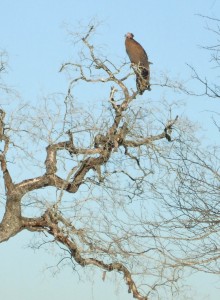 11am, Leo Lapa
11am, Leo Lapa
Back from the morning safari drive. It was apparently disappointing from the conventional perspective, having missed any of the ‘Big Five’ animals, but after seeing hippos, crocodiles, kudu, impala, waterbuck, monkeys, leopard-headed [sic – see Part Two for their proper name] vultures, fish eagles and a rapidly-trotting warthog, we were far from dismayed.
1pm, Leo Lapa
Have been in the pool!
Sunday 10th June, 10.30am, Leo Lapa
A lazy morning, waiting for Bianka to look at the electrics (of more anon) and a chance to catch up with the story so far. So, where were we?
Ah yes, feeling obliged to run, not so much to get to the gate on time (by now I had no idea what time it actually was, and it was unlikely that the few seconds saved would be significant one way or the other) but simply to demonstrate to the Air France people that I knew I was late, and was sorry about it. This was, as I’m sure you’re about to point out, a less than impeccable line of logic; there was no way, even with my overdeveloped British conscience, that the delay could be considered as my fault (even the initial booking, on Air France’s own website, didn’t give me the sensible option of the half past five flight from Dublin) and I’m quite sure that a nonchalant saunter, or even a disgruntled amble, would have met the case quite satisfactorily. It’s odd, as Helen and I just noted, on the distinction between sitting upright doing nothing, and lying back on a sun lounger doing ditto, how we imbue these neutral physical actions with moral significance. So I ran, having prepared for the eventuality –
2.50pm, Leo Lapa
That sentence was interrupted by Larissa, who burst onto the terrace in her pyjamas to announce the arrival of an elephant, which turned out to be five elephants. I’ll catch up sometime; maybe on the flight home?
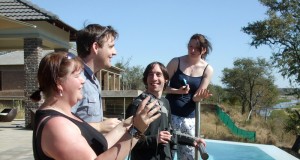
– by limiting my hand luggage to a small backpack and tiny bag, worn crosswise over my shoulder and chest, for the really essential stuff. What I hadn’t considered was the size, weight and general cloddishness of the walking boots I’d decided, at the last minute, to wear for the journey (and which, given the weather in County Fermanagh, had up to that point been a jolly good call). So, it was less a sprint than a lumber, but all the same I was thoroughly hot, breathless and generally discombobulated by the time I saw, her arms outstretched like a jovial guardian angel, my cousin Helen.
10.45pm, Leo Lapa
Lovely evening safari drive: more elephants, giraffes, wildebeest and an elusive cat-thing. That’s all I can manage to write for the moment.
Monday 11th June, 7am, Leo Lapa
I’m sitting up in bed with the cold winter sun edging around the long curtains. Helen has gone for breakfast; she, Suee Lee, Swoi Hoon, Larissa and Tom are driving around Kruger this morning while the rest of us: Gawain, Sue, Lin, Ross and I go to the Jane Goodall chimpanzee reserve. I’m aware that so far I’ve introduced no one but Helen, and even she only as a sort of embodied embrace, but I promise to tell you about the others before very long.
To get back to the tale, and the appearance of Helen (pictured right), we hugged (as would have been distinctly bathetic had we not, having approached one another with such extravagantly outstretched arms), exchanged pleasantries with the motherly Air France lady, whom Helen had acquainted with our predicament, and hurried onto the plane.
There’s very little to be said about the flight other than that it was as good as could be expected, with plentiful food, decent wine and a wide variety of electronic entertainment, of none of which we actually wanted to avail ourselves [oops, that’s a nasty construction, only noticed while typing]. What we actually wanted to do, after catching up with the three months since we saw one another last (we’re quite close, as cousins go, being separated by six years but united in vaguely creative pursuits (she’s a very a good graphic designer – website here), ownership of dogs called Robbie, memories of childhood summers in Dorset, a disinclination to expose our bodies in less than entirely encompassing swimsuits, cycling husbands (hers is about to do an unsupported ride from Land’s End to John O’Groats – sponsor him here) and much hospitality given by them and gratefully received by us over years of events in London (most of them at the Magic Circle, but that’s quite a different story)
Where did that sentence begin? Ah, yes.
was sleep. Sadly, sleep was not vouchsafed unto us, though we wriggled about a lot, pretended to be asleep in the hope that we could fool our bodies into shrugging and saying ‘Oh, very well then,’ and dozed very fitfully. Eventually, though, as has been noted elsewhere, the longest night does come to an end, and our end was, after all, in Africa, a continent new to both of us. There was an interesting moment at Passport Control, when the guy allocating passengers to booths, a sort of immigration triage nurse, told me to take off my specs (I was wearing them in preference to contact lenses for the journey) and then to go to kiosk 21. I looked up and down in desperation at the series of furry blobs into which the airport had disintegrated but fortunately Helen was directed to the same booth, and able to prod me in the right direction.
Wednesday 13th June, 11.20pm, Leo Lapa
A bit of a gap there, most of which was accounted for my the wedding, about which I don’t intend to write here, other than to mention that between fifteen and twenty elephants came down to the river in the afternoon, a healthy enough fertility symbol for any prospective grandmother. I’d better get on and finish this quickly, before my spare time is entirely taken up with crocheting bootees. (I should perhaps mention that the only bootees I’ve ever actually crocheted were for Gawain himself, and were ludicrously small even at his 39 week birth. It’s likely, therefore, that however inept I am at keeping a journal, I would be far more so at matriarchal handicrafts. Which brings us back to the elephants.)
The other reason I haven’t written anything is that we spent most of today in Mozambique. Well, we spent most of the day trying to get into Mozambique, and the small leftover scintilla of time (as we lawyers used to say) actually in Mozambique. More on this story in a later bulletin.
Thursday 14th June, 11.15pm, Leo Lapa
Well, that’s nearly it; a lovely day today – brunch, Kruger Park, outdoor dinner and board games Tomorrow morning the estimable Mornay arrives to take us back to Johannesburg. It’s been a truly wonderful week, but now, like all of us, I’m missing M and yearning to be home. ( I mean the home bit, principally, so far as the others are concerned; I’m sure they’d all, especially Ga and Sue, love to see M, but it would be slightly weird for a newly married man to be actively pining for his his papa.) Meanwhile, possibly the flight will give me time to bring this a little closer to being up to date.
Friday 15th June, 1.10pm, somewhere between Nelspruit and Johannesburg
On the road again, in Mornay’s (smaller) minibus, heading back to Johannesburg airport. Matters are slightly complicated by Helen’s having dislocated her knee. ‘Wtf?’ as her husband put it, succinctly, if not quite elegantly, in his text message. I shall leave you, fair reader, to speculate as to how the injury was sustained – saving the rest of the party from a stampeding rhino; performing gymnastics on the back of a matriarchal elephant or simply wrestling with a ravenous lion? The suspense is, we trust, just about bearable.
Saturday 16th June, 9.35am, above Paris
Well, we’ve survived the night, Helen with the help of fairly copious quantities of codeine and ibuprofen, me with my elephant book* and half of her miniature bottle of red wine (it was when she refused more than half a glass that I knew she was really in a bad way). The delightfully efficient Dutch stewardess has promised a wheelchair to meet us and the connection time is pretty generous in this direction, so there shouldn’t be too much to worry about (except poor Helen’s excruciating pain). And yes, I do remember that I said the same sort of thing as I approached Paris from Dublin, and no, I won’t reveal the secret of the dislocation yet. I have to keep my readers somehow.
*The Elephant Whisperer by Lawrence Anthony, which I’ve been reading for the entire trip, and has imbued me with lots of slightly flaky ideas.
12.20pm, Amsterdam airport
At the gate for my final flight to Dublin, Helen having been whisked off in a giant buggy to some sort of wheelchair-users’ holding area, which I didn’t manage to find. The airport is calm and civilised, with a library, museum shop and elegant lounges in one of which a young girl was playing the grand piano. And our Aer Lingus plane has just drawn up and I can see that it is called Saint Macartan – surely a propitious omen.
Part Two
(though the date is now pretty much immaterial)
Sitting in the study looking at the not-actually-quite-rain-yet, it’s time to fill in the gaps.
The narrative, I see, left us on the first Friday at Johannesburg’s passport control, with me blinking at the blob in front of me and hoping that it was really the immigration officer’s face and not some fellow traveller’s backpack. It was, and having passed the rigorous interview (‘Why have you come to South Africa?’ ‘For a holiday’), our passports were duly stamped, giving us permission to stay until September.
Next came baggage reclaim, at which we witnessed an interesting little cameo. A lugubrious beagle was roaming the hall, sniffing enthusiastically, and stopped by the woman standing next to us. She’d just retrieved her cabin luggage from the carousel, but he wasn’t interested in that; nosing instead at her small rucksack. The woman, vaguely blonde in her early thirties, didn’t look like a drug smuggler to me, but I’m aware that I’m woefully out of date in matters of a narcotic nature. The dog’s handler, a young woman in a dark green polo shirt, arrived and, saying very little, waited for the other to extract the contraband, a small paper bag.
‘It’s cheese,’ she explained. ‘I bought it at the airport in Paris. I thought it would be all right from the airport.’
I noticed then that the handler’s polo shirt bore the logo of the Department of Agriculture. It was far from all right, it turned out, and the offending fromage was duly confiscated. The blonde woman looked rueful but didn’t argue. (It’s the same in the other direction, it turns out, which is why I didn’t buy anything from the Taste of Africa shop on the return journey except sweets, chai tea and peppercorns.)
Helen and I, witnessing all this in silence, too abashed even to venture a pat towards the satisfied beagle, saw, with mighty relief, our own bags trundling towards us. We lugged them onto our trolley and hastily through the exit, before their possibly enticing odours could be investigated by the noses of the canine inspectors. We’d done it. We’d got into Africa.
 The next challenge was to find our friends-and-relations. The arrivals hall (pictured right by Ross & Lin at a quieter moment) was, by the time we arrived, packed with people, most of them corralled behind railings in an amorphous blob of humanity and cardboard signs. Fortunately Gawain, being six foot six or thereabouts (the tape measure ran out long ago) is never difficult to find in a crowd, and he’d already spotted us. Hugs, introductions and more hugs ensued. Everyone else was already there, only waiting for us, and for Tom to persuade the bureau de change to allow him a moiety of rand (they were a good deal less helpful than the ones in Dublin, but then they I suppose they didn’t have a football championship to get excited by).
The next challenge was to find our friends-and-relations. The arrivals hall (pictured right by Ross & Lin at a quieter moment) was, by the time we arrived, packed with people, most of them corralled behind railings in an amorphous blob of humanity and cardboard signs. Fortunately Gawain, being six foot six or thereabouts (the tape measure ran out long ago) is never difficult to find in a crowd, and he’d already spotted us. Hugs, introductions and more hugs ensued. Everyone else was already there, only waiting for us, and for Tom to persuade the bureau de change to allow him a moiety of rand (they were a good deal less helpful than the ones in Dublin, but then they I suppose they didn’t have a football championship to get excited by).
 Tom, in fact, was the only member of the waiting party, apart from Gawain and Sue themselves, whom I already knew. We’d first met some eighteen years before, when he and Gawain were in cut-throat competition for the British under eights chess championship. Rivalry had long since mellowed into friendship, and he was the clear favourite for the role of groom’s supporter, right hand man and general best mate. I was also relieved to note that his fashion sense had improved exponentially since he was seven.
Tom, in fact, was the only member of the waiting party, apart from Gawain and Sue themselves, whom I already knew. We’d first met some eighteen years before, when he and Gawain were in cut-throat competition for the British under eights chess championship. Rivalry had long since mellowed into friendship, and he was the clear favourite for the role of groom’s supporter, right hand man and general best mate. I was also relieved to note that his fashion sense had improved exponentially since he was seven.
The equivalent role on the distaff side (is that right?) was brilliantly played by Larissa. She and Sue hadn’t known each other all that long, but had plenty in common, both being expat Kiwi nannies in London, and she was clearly a shining jewel of a friend. (The picture on the left, in case you hadn’t guessed, shows Larissa and Tom observing elephants.)
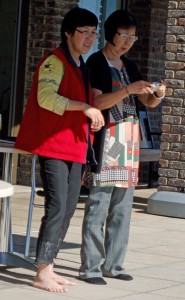 Two small ladies (pictured left) were introduced as Sue’s mother, Suee Lee, and aunt, Swoi Hoon, and welcomed us with gentle courtesy. The other two guests, of whom I’d heard much, and all of it enthusiastic, were Ross and Lin, the New Zealand couple whose extraordinary friendship, generosity and humour had transformed the months that Sue and Gawain had spent in Wellington a couple of years before. The picture below, characteristically colourful, shows them at Chimp Eden – of which much more later.
Two small ladies (pictured left) were introduced as Sue’s mother, Suee Lee, and aunt, Swoi Hoon, and welcomed us with gentle courtesy. The other two guests, of whom I’d heard much, and all of it enthusiastic, were Ross and Lin, the New Zealand couple whose extraordinary friendship, generosity and humour had transformed the months that Sue and Gawain had spent in Wellington a couple of years before. The picture below, characteristically colourful, shows them at Chimp Eden – of which much more later.
Last, but decided not the other thing, was Mornay (below left), who was to drive us across country to Leo Lapa. Helen had come across him first, several weeks before, while we were cogitating over transport options. What had first impressed her, as a designer, had been the quality of his website, closely followed by the assiduity with which he utilised social media. We were soon to find, however, that Mornay’s virtues lay far deeper than mere Twitter-fluency and a good eye for a Facebook photo.
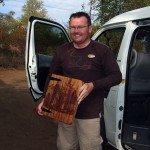 The first test of his wisdom and patience came within minutes, as we tried to drive out of the airport car park. I didn’t grasp the actual problem, but it was something to do with an immovable barrier and the fact of our being in a virtually irreversible 14 seater minibus plus trailer. The real difficulty, though, probably wasn’t physical at all. The Rainbow Nation of South Africa has eleven official languages, which is wonderful for diversity and creativity and self-respect. The other things that come along with them, the misunderstandings and confusion and delays, are, according to the good guys like Mornay, just part of the price the country has to pay to build a future of peace and justice. English is used as the lingua franca, but as anyone who has travelled is aware, there’s a lot more to communication than just converting phrases from one language to another. Translation is an art, three-way translation a sophisticated art, and its nuances, though fascinating, are perhaps best considered elsewhere than in a concrete bunker with a queue building up behind.
The first test of his wisdom and patience came within minutes, as we tried to drive out of the airport car park. I didn’t grasp the actual problem, but it was something to do with an immovable barrier and the fact of our being in a virtually irreversible 14 seater minibus plus trailer. The real difficulty, though, probably wasn’t physical at all. The Rainbow Nation of South Africa has eleven official languages, which is wonderful for diversity and creativity and self-respect. The other things that come along with them, the misunderstandings and confusion and delays, are, according to the good guys like Mornay, just part of the price the country has to pay to build a future of peace and justice. English is used as the lingua franca, but as anyone who has travelled is aware, there’s a lot more to communication than just converting phrases from one language to another. Translation is an art, three-way translation a sophisticated art, and its nuances, though fascinating, are perhaps best considered elsewhere than in a concrete bunker with a queue building up behind.
As suggested, though, Mornay’s virtues are legion, and include tact, persuasion and gentle firmness, so we were soon out into the winter sunshine. The eastern road out from Johannesburg through the province of Mpumalanga into Mozambique is a wide and smooth one, and we made good time, passing turnings for exotically named towns like Waterval Boven, Kwaggaskop and, er, Belfast. Helen and Larissa had both declared themselves in need of sleep, and so had dispatched themselves to the back of the bus to snooze. The results were rather like a little girls’ slumber party with chatter and giggles permeating through to the front, where Lin was preparing a shopping list of the groceries we’d need for the week. I spent most of the first few miles with my fingers shoved in my mouth to keep from squeaking aloud at the narrowness with which South African drivers overtook and sliced in front of one another, but soon, disturbingly soon, in retrospect, became accustomed to it.
We stopped at a small service station for lunch; a familiar enough sort of place to all of us, with a cafeteria, fast food counter, loos and shop, a miniature version of Newport Pagnell or Watford Gap. But, oddly, Mornay had suggested that we look out of the window on our trip in or out (depending upon the degree of urgency) of the Ladies and Gents. There, in place of the Travelodge wheelie bins or employees on a fag break we’d expected, grazed buffalo, zebra, several species of antelope and, slightly surreal in its matter-of-fact phlegmatism, a real live rhino. Our spirits, slightly battered by long-distance travel and lack of sleep, pulled themselves together and grinned at one another. This was Africa.
Our next stop was at Nelspruit, the capital of Mpumalanga, where we lost half of the minibus’s occupants: Gawain and Sue to meet up with their wedding planner and minister, Ross and Lin to collect a hire car and do the shopping and Larissa and Tom to collect another hire car and follow us the rest of the way. The cars were collected without much more than the standard global car hire confusion, and the small convoy continued on its way. An hour or so later Mornay drove past the last of many orange tree and sugar-cane plantations and turned down a side road marked “Mjejane Game Reserve”. We were almost there.
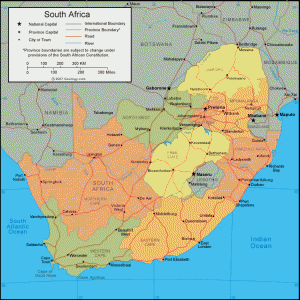 A little geography would probably come in handy here. South Africa is roughly the shape of a kidney bean, which, as kidney beans generally have no distinguishing features, is no help whatsoever. Let’s try again. South Africa is roughly the shape of a supine guinea pig with Johannesburg and Pretoria in the position of its eyes and mouth, Springbok at its back feet , the coast from Cape Town to Port Elizabeth/Nelson Mandela Bay along the edge of its bottom and the Kalahari desert the space where its paws scrabble. And along the back of its head runs a wide strip designated as the Kruger National Park.
A little geography would probably come in handy here. South Africa is roughly the shape of a kidney bean, which, as kidney beans generally have no distinguishing features, is no help whatsoever. Let’s try again. South Africa is roughly the shape of a supine guinea pig with Johannesburg and Pretoria in the position of its eyes and mouth, Springbok at its back feet , the coast from Cape Town to Port Elizabeth/Nelson Mandela Bay along the edge of its bottom and the Kalahari desert the space where its paws scrabble. And along the back of its head runs a wide strip designated as the Kruger National Park.
That’s enough guinea pigs. The Kruger National Park is, as the guide books constantly repeat, the size of Wales (Wales, like football fields, golf balls and Belgium, being a universal standard of measurement) and was established (on a much smaller scale) in 1898 by the then president, Paul – yes, you guessed it. The wildlife of the area was being slaughtered by hunting parties based in the goldrush towns, shot by farmers and losing its habitat to mining. It was a struggle to defend the park against vested interests and its occupants against poachers, but gradually, over the century, the borders of Kruger expanded and the principles of conservation became accepted by most thinking people. Not that the animals and their environment are by any means beyond danger now; the killing of rhino for their horn is increasing (see Mornay’s unique contribution to the protection campaign) and there are still boneheaded boys like Donald Trump’s spoilt sons who think there’s something impressively macho about using expensive weapons to kill elephants and, once they’re safely dead, oh-so-bravely cutting off their tails. (See Trophycruelty on YouTube, but only if your stomach’s feeling strong and you’re somewhere you don’t mind people seeing you cry.)
Not only have the borders of Kruger itself expanded over the years, but many adjoining areas have also become wildlife reserves. Mjejane is one of these, situated just south of the Kruger park, on the opposite bank of the Crocodile River. Recently the fences between Kruger and Mjejane have been taken down, so that animals can pass between one and the other freely. It’s a commercial enterprise as well as an ecological one, with building sites for sale and a smallish number of half-built and completed houses including Leo Lapa itself.
Back to our journey. The main road had, for some time, run more or less parallel with the railway line (like the road, leading from Johannesburg to Mozambique and the Indian Ocean) and, a few yards after turning off, we stopped at the Mjejane checkpoint under a railway bridge. The underside of railway bridges, it turns out (and we had plenty of time to view it) is pretty much the same in eastern South Africa as in rural Staffordshire, dark, damp and rather grubby. The subsequent conversation between Mornay and the security guards was a deja-vu-inducing reprise of the one in the airport car park. Mornay had earlier spoken on the phone to Bianka, Leo Lapa’s wonderful housekeeper/safari guide (whom we were shortly to meet, although not quite as shortly as we’d hoped) and she had told the security people that we were coming and that we should be let through the gates. A long time later it transpired that all this had indeed happened, that Bianka had given full details to the principal guard on duty and that he written it all down. Unfortunately, the place he had written it down was on the back of his hand, and he had, since then, gone off duty and home without thinking to mention it to anyone else.
Finally, though, after more demonstrations of the South African traits of good-humoured misunderstanding, long-winded explanation and a multiplicity of coloured forms to be filled in, the gate was opened and we entered Mjejane.
Whether it was sympathy at our enforced pause beneath the railway bridge, joy at the forthcoming nuptials or plain random coincidence, we never knew, but that first drive from the gate to Leo Lapa was more abundant with wildlife than any other during the next week. (The only one that came near was the final journey from Leo Lapa, when an ostrich decided to race us along the track.) There were zebras, real zebras, looking so much like giant versions of the Britain’s toys we’d had as children that we scarcely believed they weren’t anamatronic models or, at the least, mirages produced by lack of sleep and over-stimulation. But if we thought we were excited then, round the next corner, grazing at the side of the road as matter-of-factly as though they lived there (which, I suppose, they did) were a pair of….
‘Giraffes!’ cried Larissa in the car behind, raising both hands from the wheel (according to Tom, anyway) to flap them in a sort of hopeless ecstasy. Somehow the car continued to point roughly forwards.
With that kind of build-up, Leo Lapa itself was either going to be a bit of a let-down, or – or not. On the western edges of the Kruger National Park, according to the guidebooks, are a collection of exclusive private game reserves whose lodges provide sumptuous chef-prepared dinners, luxury spas, quad bikes and obsequious butlers. (I’m guessing at the ‘obsequious’ bit, preferring to imagine that they’re actually rather supercilious and enjoy pointing out errors in the guests’ pronunciation and table manners.)
Anyway, if any of us had been to any of those lodges, we might at least have pretended to be blasé at Leo Lapa. But although we were a cosmopolitan group in terms of our geographical origins, and had travelled fairly widely (especially the chess players, and Larissa who spent a year at school in Canada – French Canada, to make it trickier) our idea of luxury accommodation is pretty much met by a two-pack of digestive biscuits, an extra pillow and a trouser press.
I don’t know whether Leo Lapa had a trouser press. It had an iron (though no discernable ironing board, though both we and Bianka searched in vain for one). It did, moreover, have enormous bedrooms, named after major species of African wildlife (Helen and I were in Rhino, but neither of us took it personally) each with an almost equally enormous en-suite bathroom and its own outdoor shower (as well as the indoor one, and the standalone bath tub – we had no excuse for a skimpy personal hygiene routine). It had a big, well-stocked kitchen area, with a gigantic American-style fridge, and another one in the bar – did I mention the bar? – a full-size (I think) pool table, an antelope skull fastened, slightly disconcertingly, to the terrace railings, a gigantic sprawling-on-sofas area, fire pit and braai (the South African variant of a barbecue). It also, smooth and shimmering in the dying sun, had what’s called an ‘infinity pool’, not because of its size (as we discovered the next day, a length barely lasted two strokes) but because it was built right into the hillside, with water cascading over the edge, seemingly down into nothingness.
(picture by Lin and Ross that evening)
But all of this splendour could have been a tent and a puddle compared to the real glory of Leo Lapa; the view. From the terrace we looked straight down a few yards of tussocky grass to the Crocodile River itself, broad and fertile, and across to the wooded hillside of the southernmost and oldest stretch of the Kruger National Park. It was a breathtaking backdrop, and would become far more so before the week was out.
I couldn’t quite enjoy it yet, not until the others arrived, but finally they did, laden with shopping, and we sat down at the long refectory-type table for our first proper meal together. A braai had been the original plan, but it was growing late, and we weren’t sure of the procedure, so instead we shared fresh bread, cold meats, cheese and salad. No one stayed up very late that night (no one really stayed up late any night, what with the early mornings) and after a little desultory chat we retreated to our respective species, a little weary and very content.
(One added piece of excitement; as I looked out of the French windows in our rhino-room onto the little patio I caught a glimpse of what looked at first like the tail of a cat disappearing across the paving stones. I leaned further to check, and was heart-thumpingly delighted to see that it was actually a mongoose. Yes, a real one, just like Rikki-Tikki-Tavi.)
Saturday
If you can remember back to the halycon days of optimistic expectation that were Part One, you’ll recall that I woke at 5.30 the next morning to the soul-warming sight of a cup of tea, courtesy of Helen. She’s always been an early riser; in the summers of the 1970s she and her brother would be at Granny’s kitchen door in the morning sunshine, perplexed as to how anyone could sleep through such optimal fishing-in-the-stream time. Invigorated by the tea and the sunrise, I wrote a little in my notebook, dressed in a fleece (it was distinctly chilly) and anti-mosquito trousers*, grabbed a banana from the kitchen and joined the others in the Leo LaCar outside.
(*Extensive research on the subject (three guidebooks and the Foreign Office and NHS websites) had failed to establish a consensus about whether or not I should worry about malaria. Kruger is a high-risk zone, but we were there in the winter when most self-respecting mosquitoes have hung up their proboscises and added their buzzes to the choir invisible. My GP, however, thought better safe than sorry and I was duly equipped with anti-malarial antibiotics, industrial strength insect repellent, thiamin (the nurse’s idea) and the aforementioned trousers. As it turned out, we only saw a single mosquito on the entire trip, and that in the minibus driving through Mozambique. But I would have felt a bit silly (and quite possibly worse than silly) getting malaria when blessed with the extraordinary good fortune (in global terms) of being able to avoid it.)
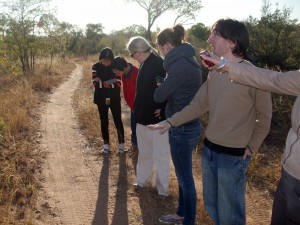 The roads in Mjejane, except for the main ones between the lodges and the main gate, aren’t passable by anything but rugged 4x4s, so we needed Bianka and the big beast to drive us around. We needed Bianka anyway, as safari virgins (except for Gawain, who’d been on a Kruger drive the year before) who couldn’t tell elephant from rhino dung (a deficiency soon remedied) and had continued difficulties in distinguishing between smooth rocks and sleeping hippos. The LeoLaCar, conveniently enough, seated ten people apart from the driver, one in the front and the rest of us in three rows of three, like a game of noughts and crosses.
The roads in Mjejane, except for the main ones between the lodges and the main gate, aren’t passable by anything but rugged 4x4s, so we needed Bianka and the big beast to drive us around. We needed Bianka anyway, as safari virgins (except for Gawain, who’d been on a Kruger drive the year before) who couldn’t tell elephant from rhino dung (a deficiency soon remedied) and had continued difficulties in distinguishing between smooth rocks and sleeping hippos. The LeoLaCar, conveniently enough, seated ten people apart from the driver, one in the front and the rest of us in three rows of three, like a game of noughts and crosses.
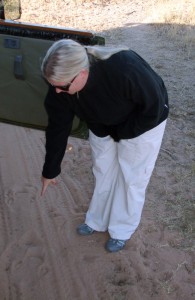 The zebras and giraffes who had greeted us the afternoon before were presumably having a lie in, for we saw none of them that morning, together with no elephants, no rhino (though the digestive products of both were much in evidence) and no big cats (though we all got out for Bianka to show us a lion’s pawprint in the sand. But there were lots of other celebrities, if not quite A-list: hippos basking on the edge of the dam, surprisingly, almost painfully, pink in real life, alongside the huge still crocodiles, mysteriously atavistic, that made me shiver even in the growing sunshine. We learned to tell impala, the most numerous of the antelope, delicate with their angled horns and striped rumps, from the big shaggy waterbuck and the gentle kudu with their Adam Antesque eye stripes. We saw little vervet monkeys playing in a tree and a rapidly-trotting warthog, looking oddly familiar, as we realised that most of our knowledge of tropical wildlife was drawn from the Lion King and the Disney version of the Jungle Book.
The zebras and giraffes who had greeted us the afternoon before were presumably having a lie in, for we saw none of them that morning, together with no elephants, no rhino (though the digestive products of both were much in evidence) and no big cats (though we all got out for Bianka to show us a lion’s pawprint in the sand. But there were lots of other celebrities, if not quite A-list: hippos basking on the edge of the dam, surprisingly, almost painfully, pink in real life, alongside the huge still crocodiles, mysteriously atavistic, that made me shiver even in the growing sunshine. We learned to tell impala, the most numerous of the antelope, delicate with their angled horns and striped rumps, from the big shaggy waterbuck and the gentle kudu with their Adam Antesque eye stripes. We saw little vervet monkeys playing in a tree and a rapidly-trotting warthog, looking oddly familiar, as we realised that most of our knowledge of tropical wildlife was drawn from the Lion King and the Disney version of the Jungle Book.
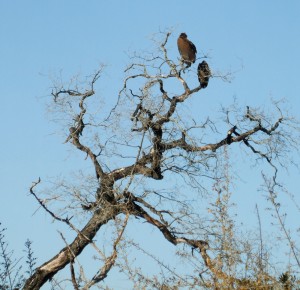 Speaking of which, we also saw, to Helen’s particular delight, plenty of vultures, including two of what I described at the time as leopard-headed vultures, later amended to lapid-headed, and are actually called lappet-faced, the largest species, and rarely seen, especially in pairs. We did well on birds, also seeing several fish eagles and lots of the gorgeously coloured smaller species, glossy starlings, rollers and hornbills. By the end of the safari, having even seen a sausage tree (and thought wistfully of our dogs back home) we felt thoroughly immersed in bush lore, though what I was really yearning to see by then was a slice of well-buttered toast.
Speaking of which, we also saw, to Helen’s particular delight, plenty of vultures, including two of what I described at the time as leopard-headed vultures, later amended to lapid-headed, and are actually called lappet-faced, the largest species, and rarely seen, especially in pairs. We did well on birds, also seeing several fish eagles and lots of the gorgeously coloured smaller species, glossy starlings, rollers and hornbills. By the end of the safari, having even seen a sausage tree (and thought wistfully of our dogs back home) we felt thoroughly immersed in bush lore, though what I was really yearning to see by then was a slice of well-buttered toast.
Back at Leo Lapa the toast was duly popped, after which one or two of us turned a thoughtful eye towards the infinity pool. Helen, who spends a bracing amount of time on the Isle of Arran, was the first to brave it, followed by a couple more of the courageous sex, and finally Tom, defending the reputation of the men. It was, we proclaimed through chattering teeth, splendid, though Helen was the only one, I think, to repeat the experience.
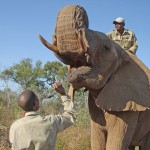 After lunch we were off on another expedition, to a nearby small game reserve where Gawain and Sue were due to ride on elephants and the rest of us to take part in a ‘bush walk’, like a safari but on foot. The activities began with our being introduced to the two tamed (-ish) elephants, one of whom had the party trick of identifying items (hats, bags etc.) by their scent and returning them to their owners. We were a little sceptical, when Lin pointed out quietly that the elephant’s handler had decided the distribution of both the items and the participants, but it was a good show. After this, Sue and Ga were established, rather painfully, on the back of a single animal and led away.
After lunch we were off on another expedition, to a nearby small game reserve where Gawain and Sue were due to ride on elephants and the rest of us to take part in a ‘bush walk’, like a safari but on foot. The activities began with our being introduced to the two tamed (-ish) elephants, one of whom had the party trick of identifying items (hats, bags etc.) by their scent and returning them to their owners. We were a little sceptical, when Lin pointed out quietly that the elephant’s handler had decided the distribution of both the items and the participants, but it was a good show. After this, Sue and Ga were established, rather painfully, on the back of a single animal and led away.
The subsequent events, were, unfortunately, another saga of imperfect communication. The rest of us, after waiting for a long time next to a table on which was placed a large receptacle marked ‘Tip Box’ (no confusion there) were taken to another part of the forest (as it were) and introduced to the bush walk guide, a rather irritatingly good-looking young man named Stef with piercing blue eyes and a disturbing tendency to wave his rifle around.
 After issuing us with the ground rules; single file, no talking, if something scary happens Don’t Run Away, he led us across the dry grass, introduced us to some interesting trees (so interesting that I’ve by now forgotten their names) and finally brought us to another dam, much smaller than the one where we’d seen the hippos and crocodiles in the morning. From there we saw, eventually, in my case (one recurring theme of the week was my difficulty in making out any wildlife until everyone else had been watching it for several minutes) a female rhino with her young calf.
After issuing us with the ground rules; single file, no talking, if something scary happens Don’t Run Away, he led us across the dry grass, introduced us to some interesting trees (so interesting that I’ve by now forgotten their names) and finally brought us to another dam, much smaller than the one where we’d seen the hippos and crocodiles in the morning. From there we saw, eventually, in my case (one recurring theme of the week was my difficulty in making out any wildlife until everyone else had been watching it for several minutes) a female rhino with her young calf.
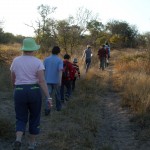 We walked around the dam, as quietly as possible, to get nearer to them, but we were a large group as these things go, and didn’t manage to make ourselves anything like as inconspicuous as we would have needed to be to get really close. It was fascinating though, even for those of us not already fascinated by Stef.
We walked around the dam, as quietly as possible, to get nearer to them, but we were a large group as these things go, and didn’t manage to make ourselves anything like as inconspicuous as we would have needed to be to get really close. It was fascinating though, even for those of us not already fascinated by Stef.
Back at the gates, however, we found Gawain and Sue, who had spent almost the entire duration of our walk waiting for us. The guides had thought that they were supposed to be joining the bush walk and so had ended the elephant ride just as we had disappeared out of sight. They’d found an engaging baby to talk to, but it was scarcely the same thing.
On the what-should-have-been short trip back to Leo Lapa, I travelled with Ross and Lin in their hired Merc, together with Suee Lee and Swoi Hoon. We needed milk and a few odds and ends including pasta for the vegetarian bake I was supposed to be making for part of the supper. The only place open, it turned out, was a petrol station, but we managed to find most of what we needed urgently there, including some rather 1950s-style macaroni. Sadly, whether it was the darkness into which the landmarks had been plunged, or my relentless chatter about Ga’s childhood chess (I suspect the latter) we missed the turning for Mjejane and spent what seemed an slow and scary journey, though was probably only a few miles, driving up and down looking to get our bearings. Finally, however, we did, and arrived back not too terribly late to find the others preparing the braai. It seemed unlikely, burning wood in the pit on the terrace until hot through, then moving the pieces onto the long metal grill, but it worked excellently. Not quite so excellent was the large oven, which had a control knob marked up to 270 degrees centigrade, but barely seemed to reach 160 in real temperature*. (Bianka is sorting it out, though, so future guests shouldn’t have the same problems). The vegetables in my pasta bake were consequently rather crunchier than intended, though everyone was very polite, and I daresay it was healthier that way.
After supper we played a game of 30 Seconds, one of a collection provided by Leo Lapa, a sort of Taboo in which the idea was to describe famous people, films etc within the designated half minute. It was a South African game, however, and the fame of several of the answers was probably domestic only. We had fun, though, and managed (not always easy with our family) not to take it too seriously.
(*I think there must have been a problem with the wine bottles, as well, because far more seemed, by the morning, to have been emptied than any of us remembered.)
Sunday
Some of the party got up early again, for more elephant rides and microflights. I decidedly didn’t. When I did finally stir, it was to find that electric power had vanished from the kitchen. Only the kitchen, fortunately, so the large fridge in the bar was rapidly called into more serious use than chilling the white wine. (It can, I’m aware, be quite rationally argued that there is no more serious business, in warm weather, than ensuring that white wine is properly chilled. I have considerable sympathy with that argument, but there was an awful lot of meat left even after the previous night’s braai.) The kettle and toaster were similarly transported and breakfast taken, though we were concerned about the fate of the frozen stuff. A series of little search parties hunted through Leo Lapa for a fuse box but none was found, except for the two I came across in the control room beneath the pool. One was already open, and I lifted the lid away from the other to disturb a fat gecko, only just small enough to squeeze inside, for whom it had obviously been a comfortable cabin. He scuttled away and I waited a few moments for my heartbeat to slow down again before continuing the search. When Gawain got back from the morning’s activities he phoned Bianka, and the mystery was solved in the best country-house detective-story tradition, with a locked room, the existence of which none of us had suspected. What was more, the room contained not only the fuse boxes, heating controls and Christmas decorations for the whole house, but also the fugitive ironing board. All was well.
All became even more well, as recorded in Part One, when several of us sitting on the terrace and minding one another’s business were dramatically joined by Larissa in her pyjamas (she’d gone back to bed with the idea of a nap after her early start) arms flapping in true-giraffe-spotting mode and an expression of utter joy on her face.
‘Elephant!’ she cried. (Larissa has a gift for getting to the heart of the matter.)
Even so, I couldn’t see it at first, not because it was too small, but because it was too big, a great dark outline lumbering down the opposite slope, ridiculously elephant-shaped, as though a child had pasted a cartoon cutout on a photograph of the hillside. And as we watched, it was followed by two slightly smaller ones, then a smaller yet, and finally by a tiny baby elephant, so small that it seemed in danger of being trampled by its mother or aunt.
I ran frantically back to Rhino to get the video camera, but the first few minutes of footage are crazy with the shaking of my hands. After that I managed to attach the camera, with the brilliant GorillaPod, to the edge of the railings and so to record most of the next fifteen minutes or so, although I entirely failed to realise that it would focus on the sprigs of vegetation immediately in front of it rather than on the distant elephants. David Attenborough probably doesn’t need to worry about being usurped quite yet.
(The music for this, by the way, is by the excellent Imperfect Scribble, not all of whom I’m related to – see their own videos here.)
The family stayed for around half an hour, paddling, drinking and washing in the river directly opposite to us and finally moving back up the hill some way from where they had come, with the great matriarch staying for longer by herself in the cool long grasses. We were all overwhelmed, and terribly sorry that Sue, Lin and Ross, who had gone to do some wedding shopping, weren’t there to watch as well.
In the afternoon we went out with Bianka and the Leo LaCar again, this time for a late drive, in the falling dusk. We took along a coolbox of drinks, beer and white wine, and enjoyed sundowners as they should be, out on the hillside with the sun setting behind the outlined trees.
This time the big animals came out for us; giraffes feeding from high leaves, elephants winding their trunks affectionately together and even wildebeest, again bearing a startling resemblance to the Disney version. As night fell, Bianka took out a large spotlight and we (at least those of us skilled at wildlife spotting, so obviously not quite all of us) took it in turns to shine it out into the bush and look out for gleaming eyes. Ga did particularly well, finding what I think was a civet amidst thick undergrowth.
Back at Leo Lapa we shared a stir fry (I can’t remember whether this one was Larissa’s or Suee Lee and Swoi Hoon’s – they were both wonderful) and a gorgeously indulgent cheesecake made by Helen. We were due for another early morning next day, so I don’t think we played any games, though neither I nor my notebook are anything like infallible.
Monday
The party divided down the middle on Monday morning – Lin, Ross, Sue, Ga and I heading past Nelspruit to Chimp Eden while the others went into Kruger for a self-drive safari, courtesy of Larissa. Ross only had to drive our little lot as far as the Mjejane River Lodge, where we met up with Solly who was to take us to the sanctuary by minibus. He was an informative and friendly chap, entertaining us with stories of teaching, or attempting to teach, white people to make the distinctive clicks which form part of the Xhosa language.
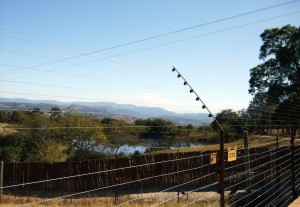 The Jane Goodall Institute Chimpanzee Eden (Chimp Eden for short) is set on another game reserve, slightly up in the hills, a little cooler than Leo Lapa. The land was originally farmed by the Cussons family, and Eugene Cussons, the Rescue Director, has raised Chimp Eden’s profile through his Animal Planet series and the book Saving Chimpanzees (which I bought at the sanctuary and can recommend as a hair-raising read, though probably more enlightening as to humans and their bureaucracies than chimp behaviour). It was quiet when we arrived (I had to keep reminding myself that this was winter, and not the summer school holidays) and Solly led us through the cool reception out into the terrace behind. Lin and I dashed into the Ladies, and I came out again to hear an oddly familiar accent.
The Jane Goodall Institute Chimpanzee Eden (Chimp Eden for short) is set on another game reserve, slightly up in the hills, a little cooler than Leo Lapa. The land was originally farmed by the Cussons family, and Eugene Cussons, the Rescue Director, has raised Chimp Eden’s profile through his Animal Planet series and the book Saving Chimpanzees (which I bought at the sanctuary and can recommend as a hair-raising read, though probably more enlightening as to humans and their bureaucracies than chimp behaviour). It was quiet when we arrived (I had to keep reminding myself that this was winter, and not the summer school holidays) and Solly led us through the cool reception out into the terrace behind. Lin and I dashed into the Ladies, and I came out again to hear an oddly familiar accent.
‘Yes,’ the voice was saying, ‘County Fermanagh is right next to County Tyrone.’
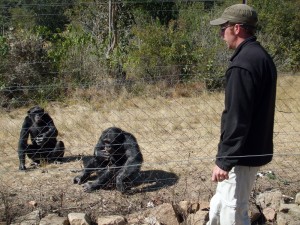 Its owner introduced himself as Murph, Chimp Eden’s IT guy and tour guide, from the village of Dromore, just sixteen miles from Enniskillen. Murph, like Stef but without the gun or the silly looks, began by telling us the ground rules (the importance of which we didn’t really appreciate until some weeks later) and we set out on our tour.
Its owner introduced himself as Murph, Chimp Eden’s IT guy and tour guide, from the village of Dromore, just sixteen miles from Enniskillen. Murph, like Stef but without the gun or the silly looks, began by telling us the ground rules (the importance of which we didn’t really appreciate until some weeks later) and we set out on our tour.
There are three enclosures within the sanctuary, each occupied by a ‘family’ of rescued chimps. A few of them knew one another before coming to Chimp Eden, but all had to be carefully observed in quarantine before being assigned to the most appropriate group, to create communities that will, so far as possible, replicate the experience of chimpanzees in the wild. ‘So far as possible’, of course, isn’t that far, since the chimps have been so damaged by human cruelty, ignorance and, occasionally, well-meant intervention. We saw chimps who had been chained up for years outside nightclubs or petrol stations, kept in tiny cages, taught to smoke and drink alcohol, dressed in restrictive clothing for years on end and left to the terrors of human war zones. Their relationships and behaviour have all been distorted, sometimes grotesquely so, and it takes immense work and patience by the staff (and often by the other chimps) to help them to recover their natural ways of acting and interacting.
Outside the first enclosure Murph introduced us to a young American who was studying the chimps as part of his research about gender differences in using tools; whether the greater use of tools by females (presumably in compensation for their lesser strength) was similar in this as in their natural environment. I’m not sure, but think he was the researcher who was attacked by two of the chimps just a couple of weeks after we were there. It seems, from the news reports, that he stepped over the outer of the two fences to pick up a stone which he was afraid the chimps might throw at the visitors he was escorting. By doing this, he went into the chimps’ own territory, and was dragged into the enclosure and severely mauled. He seems to be recovering, which has been described as a ‘miracle’, although he has lost an ear, testicle, fingers and toes. It’s a sobering reminder of the strength of the chimpanzees, and of the disastrous long-term effects of their exploitation.
Other effects, less dramatic but equally sad, are upon the daily lives of the chimpanzees. Even their most basic needs and instincts have been complicated by their disconnection from the society of their parents and peers. Although they live outside, in the large tree-filled enclosures, during the day, they don’t know how to make nests and can’t cope with night-time temperatures, and so have to sleep indoors. Although they have natural sexual instincts, and mate as they would in the wild, the young males have had no opportunity of seeing good parenthood in action and the females no experience of caring for little brothers and sisters or of learning baby-rearing skills from their own mothers. Consequently, they have to receive regular contraceptive injections to prevent the inevitable tragedy which would result from their giving birth. The eventual hope and intention is to release as many of the younger rescued chimps as possible back into the wild, as a self-contained group in a depopulated area able to contain a new tribe without territorial conflict. At the moment, though, this is a distant aspiration and meanwhile there are many suffering animals in horrendous conditions across Africa and the world, awaiting the resources that would allow them to be rescued.
All this doom and gloom suggests that we had an entirely miserable time on our tour with Murph, but the actual experience was the very opposite. The chimpanzees have been through horrendous ordeals, but they have overcome them with such courage and good spirits and live together with such thoughtfulness and zest, that we were all encouraged and optimistic. One particularly inspiring character is Joao, an elderly chimpanzee who was kept chained at a nightclub in Angola for decades, taught human vices and behaviours and suffered repeated bouts of malaria and other diseases. Despite this, he not only survived to be rescued, but recalled enough of his childhood to return to chimp behaviour, become alpha male of his group and to teach his successor all he needed to know to take over from him. Not only all this, but Joao has spent many weeks and months teaching Cozy, a severely distrurbed male who has never known chimpanzee community life, how to communicate and to behave towards others. Judged by the highest human standards of wisdom, generosity and forgiveness, Joao leaves us all a long way behind.
After the tour we had a lovely lunch out on the terrace from where we could see the younger chimps swinging in the trees, followed by a mooch around the gift shop (us, not the young chimps) and a chat about home with Murph. (Yes, I might have mentioned fracking, to which he replied, visibly shocked, ‘In Fermanagh? That’s ugly.’)
We were already quite a bit later than the tour company had anticipated, and Solly a little worried about the time, but despite that he very helpfully stopped in Nelspruit on the way back for us to sort things out at various banks. Back at Leo Lapa the others were full of enthusiasm about their trip into Kruger proper and the masses of wildlife they’d seen there. By now, though, most of our thoughts were on the next day, and the pinnacle of our week, the wedding itself.
Tuesday
As I said before, I’m not going to write about the wedding, except to say that the bride was beautiful, the groom handsome, the weather resplendent, the service moving, the food scrumptious, the guests delighted and the visit by the elephants, by which we were all outnumbered, the ultimate accolade.
Wednesday
The day after a wedding is, for most people, one of faint deflation. The bride and groom have left on their glamorous honeymoon, everything remains to be tidied away and the morning is a dejected reminder of how unhealthily we celebrated the night before. For us, though, it was all completely different. We were going to Mozambique.
The trip started in the same way as the one to Chimp Eden, in a minibus from the Mjejane River Lodge car park. Sadly, although it was the same tour company, the driver wasn’t Solly this time. We took a rather circuitous and mysterious route to the border, via another reserve and game lodge, although the minibus neither picked up nor dropped off any passengers there. As we drove, the driver, a white South African woman, gave us a brief history of Mozambique and in particular the long wars of the late twentieth century which have left the country brutally battered and broken. The only Mozambican history I knew was a few paragraphs from the Lonely Planet guide, but even I could tell how partial and partisan her account was. As the Lonely Planet writer puts it:
“Renamo [the ‘Mozambique National Resistance’ who fought against the Mozambique government] had been created solely by external forces, rather than by internal political motives. They had been established in the mid-1970s by Rhodesia as part of the destabilisation policy, and after Zimbabwe’s independence their training was taken over by South Africa. There were no aims beyond the wholesale destruction of the social and communications infrastructure within Mozambique and thus the destabilisation of the government and the country. Commentators have also pointed out this was not really a ‘civil’ war either, but one between Mozambique’s Frelimo government and the external forces which created Renamo.”
(Lonely Planet, Africa – The South, 1997, p. 302)
According to our driver, however, the ‘civil war’ was one between ‘Communism and democracy’, with Renamo flying the flag of freedom. I didn’t argue, for lots of reasons; cowardice, unwillingness to make a scene, the fact that I was at the back of the bus with a few more white South Africans between us and the front, added to the point, as I’ve said, that my knowledge of the region’s history was hardly comprehensive. I contented myself instead with a bit of low muttering and with rolling my eyes, so energetically that I could feel the muscles at the back of them aching for the rest of the day.
Just over the border, at a little place called Ressano Garcia, we trooped out of the minibus to get our visas. I think we all expected this to be a fairly simple matter, a question of handing over a fee, much-needed by the beleaguered Mozambique economy, possibly having our passports stamped, and clambering back onto the minibus again. We were wrong.
It started with the forms, long, comprehensive forms that required us to state who we were, where we lived, for whom we worked and in what capacity, our marital status and maiden names. I don’t think it asked which football team we supported, the colour of our bedroom walls or whether we’d had chicken-pox, but I can’t be quite sure. Those were the easy parts, anyway. (It didn’t help that hardly any of us had brought a pen, apart from Lin who brandished a wonderfully camp little pink ostrich feather number.) We also had to state where we were crossing, why we were going to Mozambique (by now we were asking ourselves the same question) and what, precisely where and for how long we were aspiring to do if and when they let us in. For these we had to ask assistance of our driver, which proved to be something of a mistake. For some reason, presumably South African pride, instead of telling us to write ‘Ressano Garcia’ as the place where we were entering Mozambique, she advised us to say ‘Komatipoort’, the last major town in South Africa before the border. I finished my form first, and handed it to the small, mild-looking immigration officer. He started reading it, his face puffed up a little, and he stopped looking mild.
‘Komatipoort?’ he cried. ‘Komatipoort is in South Africa! We are not in South Africa! We are in Mozambique!’
‘I’m sorry,’ I said. ‘What should I put there?’
He pointed, with trembling fingers, towards the wall, festooned with a series of signs and posters. ‘That!’
Fortunately, by some blessed quirk, we managed to identify one among the notices which bore the name of Ressano Garcia, and guessed that this was where we were. If we’d instead filled in the space with the Portuguese (Portuguese is the colonial and hence official language of Mozambique) for No Smoking, which we might as easily have done, we would probably still have been there today.
Next came the photographs. The Mozambican immigration system is fully computerised, which meant that the Ressano Garcia office had an ancient Dell laptop with an early webcam precariously balanced on the top. When we had completed our forms to the apoplectic gentleman’s satisfaction, each of us in turn had to stand in front of a blue screen to have our photo taken. Sue went first, and was firmly instructed, in a mixture of English and Portuguese, as to the precise angle at which she should stand and the exact expression of her face (strictly no smiling, as for UK passports). It all seemed a little overblown for an afternoon’s visit, and not to leave much in the way of profit for the Mozambique exchequer, but we were beginning to appreciate that this was all a part of the African experience.
Ga was next in line, and here opened another chapter of international diplomacy. As I mentioned a few thousand words ago, Gawain is not a short man. In fact, the top of his head exceeded, by a good foot, the maximum height at which the webcam could be persuaded to focus. After much discussion among the colleagues, therefore, and an impromptu game of charades to indicate what was needed, Gawain posed for his photograph in a semi-squatting position, his knees bent comically and a huge, and entirely illegal, grin across his face. Since the entire staff of the Ressano Garcia immigration department were now also grinning, this didn’t seem to matter.
The whole photography business went a bit downhill from there, not helped by the frequency with which the Dell was crashing. Oddly enough, after being sternly required to remove my shoulder bag, the half inch strap of which, across my shoulder, obviously transformed my appearance entirely, my photo turned out to be distinctly flattering, so much so that I’m planning on adopting it on my Facebook profile. Tom wasn’t so fortunate. He was the last to be processed, and by then the immigration officer was losing the will to live, never mind to keep this ragtag rabble of assorted nationalities out of his country. The sooner I let them in, he seemed to be saying to himself, the sooner they’ll go away again. The picture of Tom, therefore, missed the top half of his head almost entirely, comprising a blurred blob of indeterminate features plus an awful lot of screen. Meanwhile Ross had almost had his own camera confiscated for the heinous offence of taking a picture inside the border post. Fortunately Ross is a gentle soul, whose courtesy melts the densest linguistic and bureaucratic barriers, and so he was let off with deleting the offending images.
So, finally, we were in Mozambique. The difference from South Africa was visible immediately and everywhere, most clearly in the comparatively ramshackle and chaotic nature of the structures around, except for the large and glossy billboards advertising mobile phone companies and banks, particularly Barclays. As we approached Maputo, the capital and by far the largest city, we were growing more and more uncomfortable, not assisted by the driver’s continued commentary, describing the urban poor, sympathetically but, to our ears with little sensitivity, as ‘like sewer rats’ and ‘living in squalor’. In fact, the people we saw, though obviously extremely poor, were scrupulously clean, proud and dignified. At Maputo railway station, where we left the minibus, I had a mortifying experience of just such self-respect. I had the video camera with me, and having recorded the wedding ceremony, wanted to get as much extra footage of the party as I could. I was therefore filming the group, particularly Gawain, and Suee Lee, exotic with a scarf swathing her head, as they walked ahead of me through the station. What I hadn’t realised was that among the people sitting along the edge of the wide passage was a woman nursing her baby. Someone thought that I was filming her, and shouted angrily. It was a salutory lesson.
We visited a market, but, walking in single file as instructed (shades of the bush walk) it was almost impossible to take a proper look at anything or to engage in any way with the people around. The party stopped at a stall selling nuts – cashews and macadamias – being sold in huge quantities very cheaply and we realised that this was one of the principal points of the trip so far as South Africans were concerned. Remembering the cheese-sniffing dog, however, none of us dared to try bringing them back into our own airports.
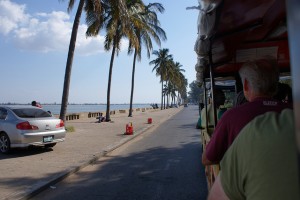 After that, we travelled around Maputo in a rather bizarrely jolly little road-train (picture by Ross and Lin), the sort that takes toddlers around in small English theme parks. It was operated by the same tour company and the political message was pretty consistent. We drove past the luxury hotels and the ambassadors’ residences and spent a longish time outside a school where the neatly-dressed, well-nourished children greeted us with slightly over-choreographed delight. ‘This is a private school,’ the tour guide remembered to mention. They weren’t by any means unkind or ungenerous people, or even racist on a personal level; one of the guides, we learned, spent a large part of her free time giving food, at her own expense, to the orphans of Maputo, but their attitudes were those of the apartheid era, and they seemed unable to make the connections between the poverty which distressed them and the institutions which maintained those conditions.
After that, we travelled around Maputo in a rather bizarrely jolly little road-train (picture by Ross and Lin), the sort that takes toddlers around in small English theme parks. It was operated by the same tour company and the political message was pretty consistent. We drove past the luxury hotels and the ambassadors’ residences and spent a longish time outside a school where the neatly-dressed, well-nourished children greeted us with slightly over-choreographed delight. ‘This is a private school,’ the tour guide remembered to mention. They weren’t by any means unkind or ungenerous people, or even racist on a personal level; one of the guides, we learned, spent a large part of her free time giving food, at her own expense, to the orphans of Maputo, but their attitudes were those of the apartheid era, and they seemed unable to make the connections between the poverty which distressed them and the institutions which maintained those conditions.
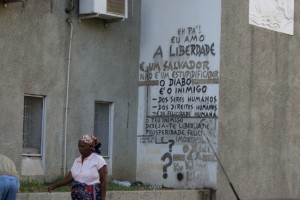 At one point one was talking about the international sanctions against South Africa, bemoaning the difficulties which they had caused to the apartheid regime and celebrating the fact that, in avoidance of the boycott, so many goods had been channelled through the war-torn and vulnerable Mozambique. I remembered the words of Dom Helder Camara, the Brazilian archbishop, ‘When I feed the hungry, they call me a saint. When I ask why people are hungry, they call me a Communist’ and appreciated more than ever those white South Africans, such as Mornay, who have entered whole-heartedly into the vision of a transforming rainbow nation. (Picture above right again by Ross and Lin.)
At one point one was talking about the international sanctions against South Africa, bemoaning the difficulties which they had caused to the apartheid regime and celebrating the fact that, in avoidance of the boycott, so many goods had been channelled through the war-torn and vulnerable Mozambique. I remembered the words of Dom Helder Camara, the Brazilian archbishop, ‘When I feed the hungry, they call me a saint. When I ask why people are hungry, they call me a Communist’ and appreciated more than ever those white South Africans, such as Mornay, who have entered whole-heartedly into the vision of a transforming rainbow nation. (Picture above right again by Ross and Lin.)
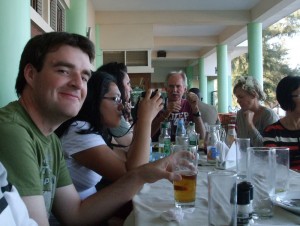 We stopped for lunch (it seemed impossible that all this had just been one morning, but I suppose we’d had an early start) at a seafood restaurant looking out onto the Indian Ocean. Afterwards we walked onto the beach where traders had goods for sale set out on blankets on the sand. I caught sight of a couple of model bicycles intricately made of twisted wire, attempted a little mild haggling but ended up, embarrassingly quickly, buying them for the initial price, with a cowrie shell thrown in. No doubt I could have done much better, but I really wanted one for M, and another for Helen, who had stayed behind at Leo Lapa. (That is, as a present for her to give in turn to her own cycling husband.) At this example of naïve consumerism, the rest of the traders suddenly gathered around me, thrusting their wares in front of my nose until I had to be escorted back to the minibus by the driver. Conservative people can be very helpful in these situations. (And she’d flattered me earlier, too, by looking between Gawain and me and saying, apparently genuinely, ‘I can tell that you’re brother and sister.’ The gratifying effects of this, were, however, to last less than two days, as subsequent events will show.)
We stopped for lunch (it seemed impossible that all this had just been one morning, but I suppose we’d had an early start) at a seafood restaurant looking out onto the Indian Ocean. Afterwards we walked onto the beach where traders had goods for sale set out on blankets on the sand. I caught sight of a couple of model bicycles intricately made of twisted wire, attempted a little mild haggling but ended up, embarrassingly quickly, buying them for the initial price, with a cowrie shell thrown in. No doubt I could have done much better, but I really wanted one for M, and another for Helen, who had stayed behind at Leo Lapa. (That is, as a present for her to give in turn to her own cycling husband.) At this example of naïve consumerism, the rest of the traders suddenly gathered around me, thrusting their wares in front of my nose until I had to be escorted back to the minibus by the driver. Conservative people can be very helpful in these situations. (And she’d flattered me earlier, too, by looking between Gawain and me and saying, apparently genuinely, ‘I can tell that you’re brother and sister.’ The gratifying effects of this, were, however, to last less than two days, as subsequent events will show.)
The journey back to Leo Lapa was comparatively uneventful, except for Tom’s difficulty in explaining to South African immigration why he had twice as much face as appeared on his Mozambican visa.
There was one thing that we noticed though, with mild trepidation at the time, and great sadness in retrospect; the trucks driving home from the fruit farms. Each was packed with workers crammed together, overflowing from the sides and open tailgate. It looked dangerous, and so it proved. Less than a month later, headlines throughout the world told of how one of these trucks drove onto a level crossing near Hectorspruit (the nearest village to Leo Lapa, where we’d bought the macaroni) and was hit by a freight train. The horror of the crash, in which the truck seems to have been dragged at least a kilometre along the track and dismembered bodies scattered widely, is suggested by the fact that as I write, three days later, the estimate of the number killed is still varying between nineteen and thirty. It’s as disturbing, in a different way, to read that the truck driver is being charged with murder. Any of us, and anyone driving along that major road, could have predicted that something like this would happen sooner or later. All of us who expect cheap food, and hold the lives of those who provide it just as cheaply, belong in the dock as well.
Back at home (Leo Lapa seemed unequivocally home by now) Helen had prepared dinner for us, giving us plenty of time to play games afterwards. Sue annihilated all opposition at Labyrinth (I’ve yet to discover a board game at which Sue doesn’t excel) and Categories was enlivened by Tom’s answer to ‘part of the body beginning with V’ to which Larissa enquired, ‘Isn’t that a make of car?’ And no, it wasn’t vox humana and Vauxhall.
Thursday
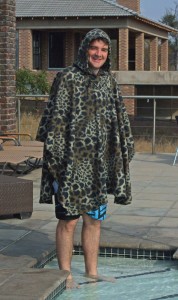 Having been generous with estimates at the beginning and the caterers having excelled all expectations in the quantity and quality of food they provided, we were now, with a maximum of one more day to go, in danger of being engulfed in a tide of food. In a Canutesque attempt to stem it, we shared a substantial brunch on Thursday morning and heroically ate as much as humanly possible. Regretfully, the Great Wedding Party was to begin its crumble that morning, for Larissa and Tom had to get back to Johannesburg for a flight in the evening. First, however, came the Dance. Larissa’s vague game-spotting arm flaps had by now developed into a full-scale routine , and it was unthinkable for her to leave without our having performed it. The discovery of a pile of fake leopard-skin ponchos, intended for night drives, was merely a serendipitous extra. So we gathered on the terrace for the last time, Suee Lee seated in central state (I think I forgot to mention that she sprained her ankle the previous day) and made silly gestures for the benefit of posterity. We’re thoughtful like that.
Having been generous with estimates at the beginning and the caterers having excelled all expectations in the quantity and quality of food they provided, we were now, with a maximum of one more day to go, in danger of being engulfed in a tide of food. In a Canutesque attempt to stem it, we shared a substantial brunch on Thursday morning and heroically ate as much as humanly possible. Regretfully, the Great Wedding Party was to begin its crumble that morning, for Larissa and Tom had to get back to Johannesburg for a flight in the evening. First, however, came the Dance. Larissa’s vague game-spotting arm flaps had by now developed into a full-scale routine , and it was unthinkable for her to leave without our having performed it. The discovery of a pile of fake leopard-skin ponchos, intended for night drives, was merely a serendipitous extra. So we gathered on the terrace for the last time, Suee Lee seated in central state (I think I forgot to mention that she sprained her ankle the previous day) and made silly gestures for the benefit of posterity. We’re thoughtful like that.
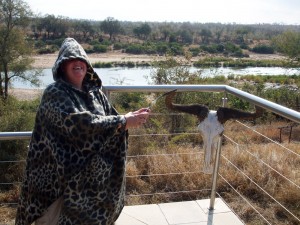 Hindsight suggests that Helen’s follow-up idea, to borrow a fish slice from the kitchen and perform ritual incantations over the antelope skull, might not have been the wisest. The spirits who preside over lower limbs were, we knew from Suee Lee’s ankle, already restless; angering them was bound to be dodgy.
Hindsight suggests that Helen’s follow-up idea, to borrow a fish slice from the kitchen and perform ritual incantations over the antelope skull, might not have been the wisest. The spirits who preside over lower limbs were, we knew from Suee Lee’s ankle, already restless; angering them was bound to be dodgy.
Anyway, we gratefully extricated ourselves from the incredibly hot ponchos, said our farewells, and waved as Larissa and Tom drove away. Then five of us; Ross, Lin, Sue, Helen and I, squeezed into the Merc and headed for Kruger for a final safari.
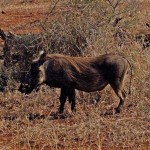 It was an abundant, glorious, treasure-filled one, beginning with a family of warthogs, and ending with a herd of wildebeest. In between came giraffes, zebras (including several examples of the zebra crossing) a couple of hippos rising from the water and walking, interminably slowly, along the sand (one with the precise physiognomy of the late Clement Freud) more elephants, a rhino, a black-backed jackal, buffalo, crocodiles and a large troupe of baboons including an enchanting baby learning to climb, swing and jump from small trees. And, at last, a lion. A lion and two lionesses. Our cup truly overflowed.
It was an abundant, glorious, treasure-filled one, beginning with a family of warthogs, and ending with a herd of wildebeest. In between came giraffes, zebras (including several examples of the zebra crossing) a couple of hippos rising from the water and walking, interminably slowly, along the sand (one with the precise physiognomy of the late Clement Freud) more elephants, a rhino, a black-backed jackal, buffalo, crocodiles and a large troupe of baboons including an enchanting baby learning to climb, swing and jump from small trees. And, at last, a lion. A lion and two lionesses. Our cup truly overflowed.
Here are some of the highlights, again accompanied by Imperfect Scribble.
 But there was still one more delight to come; supper at the Mjejane River Lodge. We gathered in the comfortable lobby before a blazing wood fire and wished Suee Lee, whose birthday it was, a happy one. One of the European football games was on the television in the corner, at least until the next power cut, after which I think they switched to the generator, and it never came back on. I don’t think even the boys really noticed. The dinner itself was outside, in long tables around a fine great fire with delicious meats, fish and salads and the southern hemisphere stars, which were beginning to seem less strange, breathtakingly splattered across the sky. It was a beautiful night in every way and we were only sorry that Larissa and Tom hadn’t been with us.
But there was still one more delight to come; supper at the Mjejane River Lodge. We gathered in the comfortable lobby before a blazing wood fire and wished Suee Lee, whose birthday it was, a happy one. One of the European football games was on the television in the corner, at least until the next power cut, after which I think they switched to the generator, and it never came back on. I don’t think even the boys really noticed. The dinner itself was outside, in long tables around a fine great fire with delicious meats, fish and salads and the southern hemisphere stars, which were beginning to seem less strange, breathtakingly splattered across the sky. It was a beautiful night in every way and we were only sorry that Larissa and Tom hadn’t been with us.
Friday
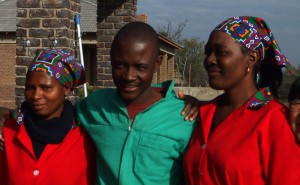 Time to go. One last wander around Leo Lapa, farewells to the wonderful staff, a quick dash to squeeze everything back in our bags and Mornay waiting outside in the smaller minibus to take us back to Johannesburg. ‘But hold on a moment,’ you say, ‘Haven’t you forgotten something? Helen’s dislocated knee, surely it happened on the safari, saving the rest of you from the lion’s bad temper? Or at the River Lodge, when a burning log was thrown from the huge fire? Surely, at the least, it happened while she was rushing around preparing your dinner for your return from Mozambique?’
Time to go. One last wander around Leo Lapa, farewells to the wonderful staff, a quick dash to squeeze everything back in our bags and Mornay waiting outside in the smaller minibus to take us back to Johannesburg. ‘But hold on a moment,’ you say, ‘Haven’t you forgotten something? Helen’s dislocated knee, surely it happened on the safari, saving the rest of you from the lion’s bad temper? Or at the River Lodge, when a burning log was thrown from the huge fire? Surely, at the least, it happened while she was rushing around preparing your dinner for your return from Mozambique?’
Alas, not. Well, not alas that it didn’t happen at any of those times, but alas that it happened at all, and just when all potential dangers and devastations seemed to be over. Actually it was as she stepped, a modest step, nothing like the haul into the Leo LaCar, up into Mornay’s minibus. The stricken expression on her face wasn’t so much pain, not at first anyway, as sheer shock.
There was pain, though, a lot of it, and she was wonderfully brave. At Nelspruit, where Ga and Sue were collecting their wedding photos, and Mornay his son; Mornay’s wife, Mary-Ann, came onto the bus and strapped Helen’s leg up for her, another kindness from the Marais family. At the airport Sue took control, found the check-in and arranged for us to have priority boarding, a change of seat to give Helen more leg room, and wheelchair assistance. All this was available, but we had to take it up immediately, so we said hurried goodbyes (Ga braving the passport control no entry zone for a final hug) and I followed the tiny African girl who was pushing Helen’s chair. (She didn’t actually want a wheelchair, but there appears no such thing as emergency airport crutches).
It was now that the vanity induced by the tour guide (the one who thought I was Ga’s sister) was dispelled. While I was off doing something or other the passenger mobility assistant leaned down to Helen with a question. ‘Is that your mum?’
What with one thing and another, we had a long time at Johannesburg airport, but somehow we passed the time. I spent quite a lot of it on an expedition around the shops, looking for presents for the boys, only to find, when I got back, that Helen was in agony and with no water left to wash down her painkillers. I can be a rubbish cousin sometimes.
There was quite some confusion at the departure gate, with us assistance passengers moved in and out of various holding areas. We pooled our final rand and shared a sandwich to keep our strength up, and every morsel of mozzarella was welcome. Finally, though, we were on the plane and in the care of the kind and conscientious Dutch cabin staff. At first we thought that our seat changes had achieved nothing but allowed us to sit together but when we finally reached them, at the very back of the plane, we realised that it was a row with two seats instead of three and so a bit of precious space on the floor in front. We (well, mainly one of us, the other one being rather occupied with managing a limb) speculated for a while about the man a couple of rows in front, who was very white, with a large very black baby he didn’t really seem to know how to manage and an accompanying nurse who seemed to be there only for the nappy changes. I thought at first that he was American and was adopting the baby, but in fact, by a bit of eavesdropping, found out that he was South African and heading for Rome. There’s a very tear-jerking girlie movie plot in there somewhere – perhaps that would do for Lin?
Anyway, I can’t say much more about the flight, because, by some miracle, we both managed to sleep at least for part of it. At Amsterdam we went our separate ways and the last I saw of Helen was as she was driven away, in some state, on a large electric chariot. After that, things were fairly dull, really, the airport as pleasant as a large airport could possibly be, the Aer Lingus plane encouragingly named after Saint Macartan, one of our local sanctified, and the airline, obviously infected by Ryanair’s meanness, charging for everything, so I had to stave off my hunger with crackers and water. At Dublin I had an hour to wait for the bus home, most of that taken up with sorting presents, and wrapping them in a primitive manner, after which it was back to an Irish summer: rain, wind and general dreariness. It was lovely to be home, though; you know exactly how that feels, the slight strangeness and the rush of familiarity and the odd sensation that perhaps the past ten days was all a dream and that, when you mention it to one of the others, they’ll say, ‘What wedding? What’s Leo Lapa? Have you been on the South African fair trade wine again?’ But I had the video, and slightly brown arms, and a bruise where I’d bumped into the table at Mjejane River Lodge and far more happiness than you ever get, even in the very best of dreams.
So, Lin, was there a plot? I’m afraid not, just a narrative arc from rain to rain, with sunshine and elephants and chocolate wedding cake in between. And yet – since we got home, the global news has told two tragic stories, both intimately linked with the people and the places that we knew in South Africa: the Chimp Eden misadventure and the Hectorspruit train crash. Both resulted, indirectly, from human arrogance and greed, the treatment of other people and other species as though they are expendable tools of our own desire. Maybe still not a plot, but a theme emerges, the old one, the need to look around us and think; to, as the prophet says, act justly, love mercy and walk humbly with our God. (Or whatever other-named goodness stands as the ground of our being.) No man is an island, even surrounded by sleeping hippos or the smoothest of rocks.
And that will have to do.
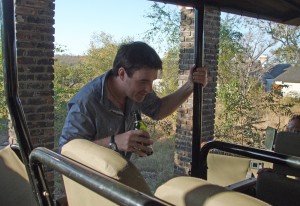
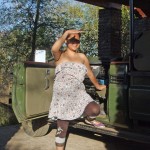
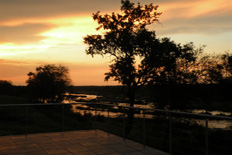


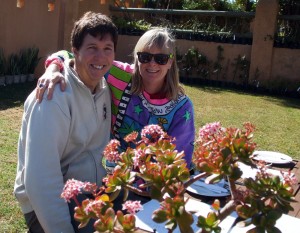

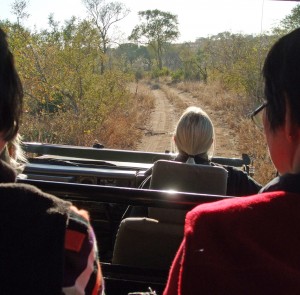

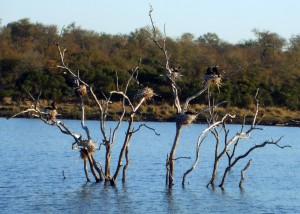

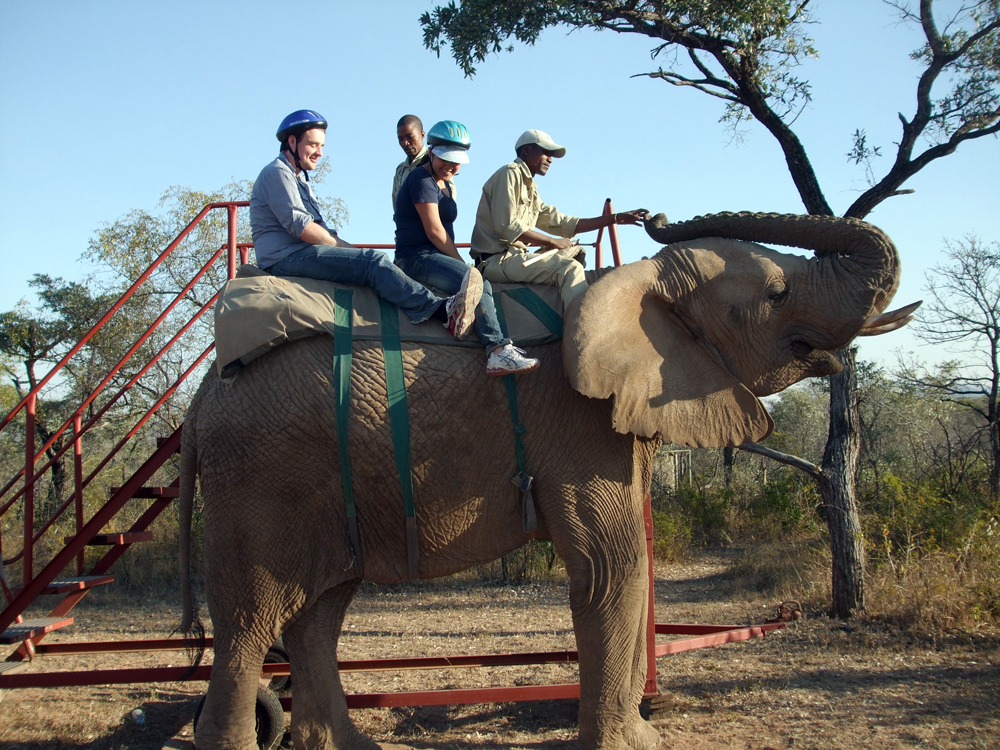


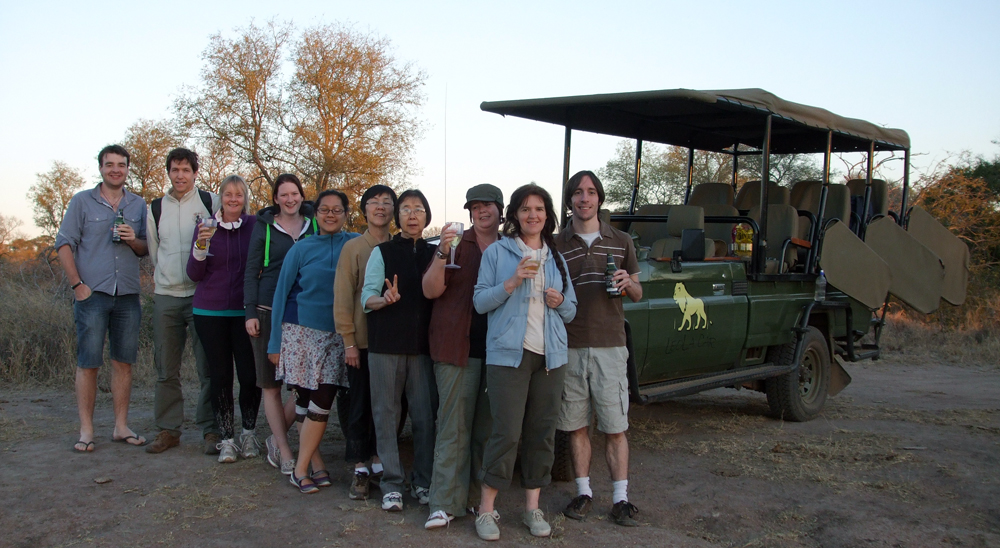
Leave a Reply